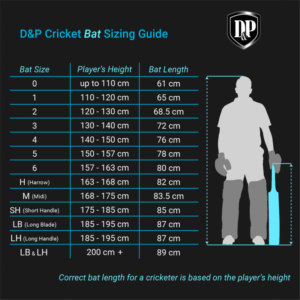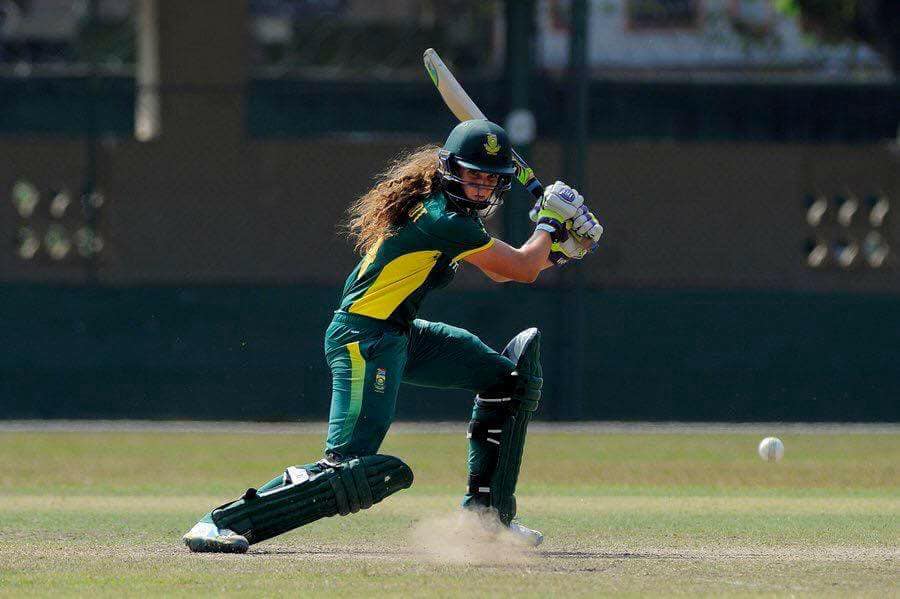Buying a cricket bat can be a daunting process so here is a step by step guide to inform you as much as possible before you make a purchase.
SIZE
The image below shows you what size is recommended depending on how tall you are. For female adults and taller youths the short handle (SH) would be the most appropriate size, this provides players with more control over the blade compared to the long handle (LH). Harrow is a bat size smaller than the short handle
 .
.
WEIGHT OF THE BAT
One of the most common mistakes female cricketers make when buying a cricket bat, is that it is too heavy. In our opinion, as long as you have got the right size bat then the lighter it is the better. This allows you to have more control over your shots and also helps you generate quicker hand speed.
3. TYPE OF WILLOW
Willow is the type of wood used to make cricket bats and there are two types to choose from:
English Willow: The best one. Grown in England and the highest quality type of wood. The growing conditions in England means that there is more moisture in the wood, resulting in the cricket bat lasting longer and giving a better performance. This type of cricket bat is the preferred option for those playing and training on a regular basis from club level upwards. As you would expect though, with better quality comes increased costs
Kashmir Willow: Grown in India in dryer and hotter conditions means the wood is dryer, harder and a little denser which can also result in heavier bats. However, cricket bats made of Kashmir willow are brilliant for those new to the game and playing recreationally – all at a more affordable cost.
THE GRADE OF THE WILLOW
Willow is graded by number, with Grade 1 being the best and most expensive, to Grade 5 being the least expensive. The grade relates to the appearance of the bat.For example, Grade 1 will be free from any marks or blemishes as well as having straight grains (the lines you can see on the face of the bat). The further down you go through the grades the more you will see markings and discolouring to the bat. See below for how to pick your grade depending on what level you play:
Grade 1: County standard and above
Grade 2: Top club or county standard
Grade 3: School or lower level club standard
Grade 4 and 5: Beginner
5. YOUR BUDGET
We understand cricket is an expensive sport to play and we hope that the above guide provides you with the information you need to buy a bat that is relevant to your needs and also suits your budget.
KNOCKING YOUR BAT IN – BAT CARE KIT
Knocking in your Cricket bat is an important process after you have purchased your new bat. Even if you a “pre knocked in” bat, further knocking is always required. Below is a step by step guide to knocking in.
Apply raw linseed oil to the face and edges of the bat evenly, 2 to 3 teaspoons of oil is the correct amount. Rub into the face of the bat and edges. Do not oil the back, labels or the splice of the bat*. (*where the handle fits into the blade). Do not over oil the bat as this will deaden the fibres of the timber and affect performance.
Leave the bat horizontal and face up to dry for 24 hours.
If you are planning to use the bat in its natural state, i.e without an anti scuff sheet, then repeat steps 1 and 2 twice more. If you are planning to have a protective anti scuff sheet fitted then one initial coat of oil is sufficient.
Wipe off any excess oil and knock your bat in with a bat mallet for approximately 4 hours. The edges and toe of the blade require particular attention using glancing blows off the face to harden and round these areas. Care and attention should be made not to hit the edges, toe or back of the bat directly as this will cause damage. The knocking in should be performed with gradual increasing force, but never too hard to cause damage.
Fibre tape is applied to the edges of the bat and an Anti scuff sheet is fitted over the top if required. We strongly recommend this procedure.
Test the blade using a good quality old ball during a light net session or having “throw downs”. If seam marks and indentations occur further knocking in is required.




